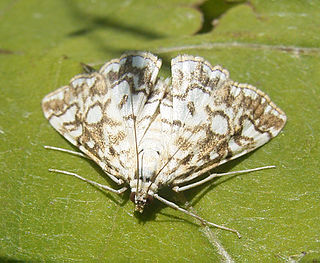
The Limenitidinae are a subfamily of butterflies that includes the admirals and relatives. The common names of many species and genera reference military ranks or – namely the Adoliadini – titles of nobility, in reference to these butterflies' large size, bold patterns, and dashing flight. In particular, the light stripe running lengthwise across the wings of many Limenitidini has reminded earlier authors of officers' shoulder marks and epaulets.

Spilomelinae is a very species-rich subfamily of the lepidopteran family Crambidae, the crambid snout moths. With 4,135 described species in 344 genera worldwide, it is the most speciose group among pyraloids.

Neptis is a large genus of butterflies of Old World tropics and subtropics. They are commonly called sailer butterflies or sailers, or more precisely typical sailers to distinguish them from the related blue sailer (Pseudoneptis).

Neptis miah, the small yellow sailer, is a nymphalid butterfly found in India, Bhutan, Thailand, and Malaysia eastward to western China, Hainan and Guangdong. Seven subspecies have been identified. The Guangdong subspecies belongs to N. miah disopa Swinhoe and the Hainan subspecies is considered as N. miah nolana Druce.

Acentropinae is a fairly small subfamily of the lepidopteran family Crambidae, the crambid snout moths. Species of this subfamily are exclusively found in wetlands and aquatic habitats.





